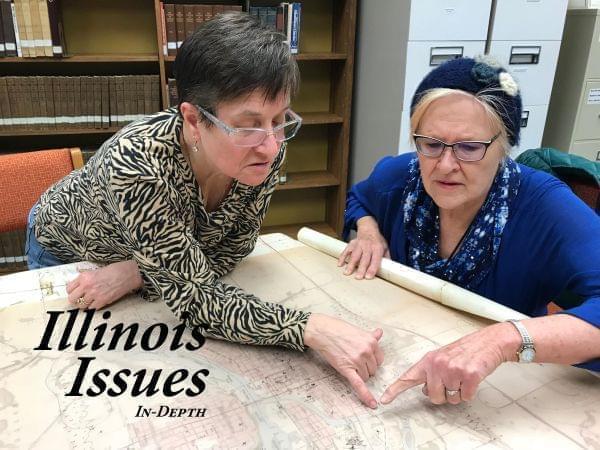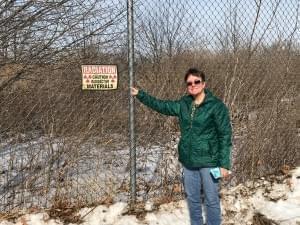Illinois Issues: The Radium Girls - Cleaning Up Contamination

The U.S. Department of Energy flew a helicopter over Ottawa, Illinois, in 1986 and identified 14 "hot spots" of radiation. Katie Troccoli and Joan Bernabi review the map created by the department at the Reddick Library. Mary Hansen/NPR Illinois
Ken Ricci refers to his purchase of a Geiger counter, a handheld machine that detects radiation, as a "God wink." The 91-year-old Ottawa resident picked it up at a garage sale in 1982. Soon after, he and a friend used it to find several hot spots of contamination throughout the central Illinois city.
Their discovery started a battle to clean up contaminants left by two companies that made glow-in-the-dark watches with radium-laced paint. That paint sickened and killed many of their workers, nicknamed the radium girls, and eventually spread radiation throughout Ottawa. While the threat to the workers' health was known, the risk of the radiation to public health in the city wasn't fully understood.
"It was kind of goofy, you buy something like [the Geiger counter]," Ricci says. "And it all kind of fell into place. Look what happened, it was all cleaned up."

Ken Ricci bought a Geiger counter at a garage sale in 1982. With it, he and a friend found more than a dozen spots with radiation in Ottawa, Illinois. Ricci tells the story at his home.
Still, there's cleaning left to do. Over the last more than two decades, the Environmental Protection Agency removed or contained radium in more than a dozen sites. But one remains.
The state of Illinois owns the area, 17 acres on the east side of the Fox River once slated to become a state park. A 2010 court order requires the state to split the cost of remediation, about $70 million, with the federal government.
People exposed to high levels of radiation could be at a higher risk of developing cancer, according to the Centers for Disease Control and Prevention. A public health study of Ottawa's radiation areas from 2006 found that the state-owned site - as well as another, which has since been cleaned up - pose a health hazard. "Residents, workers, and trespassers have a low increased risk of cancer from exposure to contaminated soil," the report reads.
As work on the second-to-last site finished last year, "attention has now shifted" to the Fox River location, according to an Illinois Emergency Management Agency spokeswoman. Illinois and the EPA have to decide on a plan and how much money will be needed each year over the three to four years it's projected to take to clean it up. Then, IEMA will seek state funding.
Ottawa officials say they've continued to meet with state and federal agencies, and are confident in their commitment to finish the cleanup.
The project could face other obstacles, including Illinois' ability to cough up millions of dollars while it faces a backlog of bills in the billions.
Meanwhile, President Donald Trump has proposed slashing federal money for the Superfund program, which allows the EPA to decontaminate hazardous sites. Ottawa has been a part of the program since 1988. However, the agency does have money to begin cleanup this year, according to a spokeswoman.
'The problem is we were right'
Ricci was part of a group, Residents Against a Polluted Environment, to fight a hazardous waste landfill proposed near Ottawa at the time he bought the Geiger counter. But the group's focus turned to radiation contamination after Ricci began finding hot spots.
At first their concerns weren't taken seriously. Ricci went to the mayor to ask that a fence be put up around the then-abandoned Luminous Processes building, where some of the radiation originated from. The state forced the factory to close in 1978 after repeated health and environmental violations.
Ricci was part of a group, Residents Against a Polluted Environment, to fight a hazardous waste landfill proposed near Ottawa at the time he bought the Geiger counter. But the group's focus turned to radiation contamination after Ricci began finding hot spots. At first their concerns weren't taken seriously. Ricci went to the mayor to ask that a fence be put up around the then-abandoned Luminous Processes building, where some of the radiation originated from. The state forced the factory to close in 1978 after repeated health and environmental violations.
Ricci says the mayor told him he was going to ruin the city's reputation if he kept talking about the radiation. They were considered the "radical fringe," jokes Katie Troccoli, who joined Ricci's group when she was 22 and a mother of two young children. "The problem is we were right," she says.
Two factors turned the tide, Ricci and Troccoli say. The state representative for the area, Peg Breslin, got involved, and later, a documentary, "Radium City," was produced about the plight of the Radium Dial workers and the contamination the companies left behind.
Breslin pushed for state funding to tear down the Luminous Processes building and haul the rubble to a toxic waste landfill in the state of Washington in 1985. The next year, the U.S. Department of Energy at the request of the state flew a helicopter over Ottawa and identified 14 hot spots.

Katie Troccoli stands at the edge of the last area in Ottawa contaminated with radium. The state of Illinois owns the area.
"It was nice to be right, but [also] not because our community was contaminated," Troccoli says. "We knew we had serious problems that would need to be addressed. And there's never any money to do these things. It was a huge hurdle that we faced."
The EPA did a two-month investigation into what caused the contamination, determining that it was from the two dial factories. When the first clock factory in Ottawa, Radium Dial, was demolished more than a decade prior, some of the rubble was used as fill for other lots around the city. Much of the rest was thrown in what at the time was the city dump, the last area that needs to be remediated.
By the time the EPA determined the cause, both Radium Dial and Luminous Processes were defunct and couldn't be sued for damages, leaving taxpayers to pick up the tab for cleanup.
Slow cleanup
Remediation began in the late 1980s, and continues today. The biggest constraint has been funding. Ottawa Mayor Bob Eschbach says that, while it may have not been the most efficient way, the EPA would get pots of money together to do a few sites, stop when the money ran out, then return when they had funds again.
"Government moves slowly," he says. "Patience and perseverance are traits you have to have when you're mayor."
The agency began first in homes where it detected radon, a gas given off by radiation that can be harmful to people. Remediation and cleanup of sites near homes and businesses was the next priority. Between 1995 and 1997, the agency removed more than 40,000 tons of contaminated soil from the city, according to EPA documents.
Driving around in her truck an afternoon this month, Troccoli shows the areas that have been decontaminated. They're in neighborhoods, the city's downtown shopping district and out by the highway and river. The football field for Marquette High School was cleaned up in the mid-2000s, along with a parking lot downtown where the Luminous Processes building once stood.

The Illinois Power Building on Jackson Street in Ottawa is one of more than a dozen sites the Environmental Protection Agency has decontaminated.
Ricci says he's pleased with the EPA's work, particularly that crews cleaned up areas where people spend the most time. He says he never considered moving because of the contamination. At least in Ottawa, they know what was there, and it's been decontaminated.
"I like the fact that they were getting rid of it. We don't know what's in the ground in Chicago, and we don't know what's in Springfield," he says. "Nobody has done anything to know."
And some people have been curious about what's in Ottawa. Every now and then David Noble, the city engineer, says he gets calls from people looking to buy a house or develop land in the city. Often, they'll ask about the contamination.
"We can look at the [site map] and explain what's happened in their area, if anything," Noble says. "And pretty much we always put their fears to rest."
Troccoli continues to worry about the former city dump that the state owns.
A car dealership and another business sit between the highway and the state-owned land. The site is cordoned off with a chain-link fence and has signs warning of the radiation contamination. An Illinois Emergency Management Agency official says the fence keeps trespassers away from the area, and the agency does periodic sweeps to ensure safety.
"One political administration after another and it just gets pushed off to the side," Troccoli says. "And then it's still there, a problem."
But Eschbach is confident in the EPA and IEMA's commitment to cleaning it up. He says in the future, he'd like to see it become a riverside park with a walking path.
Illinois Issues is in-depth reporting and analysis that takes you beyond the headlines to provide a deeper understanding of our state. Illinois Issues is produced by NPR Illinois in Springfield.
Links
- Illinois Issues: The Radium Girls - An Illinois Tragedy
- Illinois Issues: A Prescription For Fruits And Veggies
- Illinois Issues: ‘Moneyball’ - The 2018 Illinois Governor’s Race
- Illinois Issues: For East St. Louis, A Glimmer Of Hope For Housing Revitalization
- Illinois Issues: New Illinois Laws In 2018
- Illinois Issues: Stories Of The Year
- Illinois Issues: Illinois Women Tell Their #Metoo Stories
- Illinois Issues: New School Discipline Philosophy One Year Later
- Illinois Issues: Campaign 2018 - Rauner Vs. Madigan
- Illinois Issues: Third Party Candidates Want Rules Eased To Get On Ballot
- Illinois Issues: Legislative Checklist - Veto Session
- Illinois Issues: Is The State Budget Balanced?
